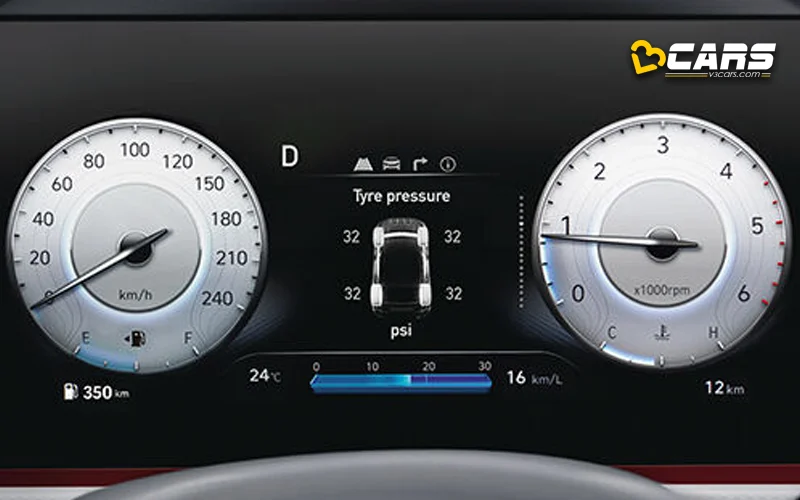Tyre Pressure Monitoring System (TPMS) - Feature Explained
In this Feature Explained article, we'll delve into the intricacies of the Tyre Pressure Monitoring System (TPMS), a crucial safety feature in modern vehicles. We'll outline its functionality, benefits, drawbacks, and the costs associated with repair, replacement, and aftermarket installation. This analysis will help you understand the importance of TPMS for your driving experience.
.webp)
What Is A Tyre Pressure Monitoring System?
A Tyre Pressure Monitoring System (TPMS) is an electronic system that monitors the air pressure inside a vehicle’s tyres in real-time. It alerts the driver when tyre pressure drops below a critical level, preventing potential hazards associated with underinflated tyres.
How Does A Tyre Pressure Monitoring System Work?
TPMS utilises sensors, either directly or indirectly, to measure tyre pressure.
- Direct TPMS: Sensors are mounted inside each tyre, directly measuring pressure and temperature. These sensors transmit data to the vehicle’s onboard computer, which displays the readings on the dashboard.
- Indirect TPMS: This system uses the vehicle’s Anti-lock Braking System (ABS) sensors to monitor tyre rotation speed. A decrease in tyre pressure alters the tyre’s rolling radius, which the ABS sensors detect. The system then alerts the driver.
What Are The Different Types Of Tyre Pressure Monitoring Systems?
- TPMS with Display: These systems provide real-time tyre pressure readings for each individual tyre on the vehicle’s dashboard display. They often include temperature readings and allow for more precise monitoring.
- TPMS with Warning Only: These systems simply trigger a warning light on the dashboard when tyre pressure falls below a pre-set threshold. They don’t provide specific pressure readings.
What Are The Pros And Cons Of Tyre Pressure Monitoring Systems?
Here are the pros or advantages of TPMS:
- Enhanced Safety: Prevents accidents caused by underinflated tyres.
- Improved Fuel Efficiency: Properly inflated tyres reduce rolling resistance, improving fuel economy.
- Increased Tyre Lifespan: Prevents premature tyre wear.
- Real-time Monitoring: Provides instant alerts to pressure changes.
Here are the cons or disadvantages of TPMS:
- Sensor Malfunction: Sensors can fail, requiring replacement.
- Cost: Direct TPMS systems can be expensive to repair or replace.
- Battery Life: Direct TPMS sensors have limited battery life.
How Expensive Is It To Repair Or Replace A Tyre Pressure Monitoring System?
The cost of repair or replacement varies depending on the type of TPMS and the vehicle. Direct TPMS sensor replacement can range from Rs. 2,000 to Rs. 5,000 per sensor, plus labor costs. Indirect TPMS repairs are typically less expensive, as they rely on existing ABS components.
Can A Tyre Pressure Monitoring System Be Fixed From The Aftermarket?
Yes, both direct and indirect TPMS systems can be installed or repaired through aftermarket services. However, it’s crucial to choose reputable installers and high-quality components.
How Much Does An Aftermarket TPMS Cost?
Aftermarket TPMS systems can range from Rs. 5,000 to Rs. 15,000, depending on the type and features. Installation costs are additional.
How Easy Or Complex Is It To Install An Aftermarket TPMS?
Direct TPMS installation requires mounting sensors inside the tyres, which can be complex and requires specialized equipment. Indirect TPMS installation is generally simpler, as it involves connecting to the vehicle’s ABS system.
What Affordable Cars In India Get TPMS?
Many affordable cars in India now offer TPMS, especially in higher variants. Examples include models from Maruti Suzuki, Hyundai, Tata, and Kia. The availability of TPMS is steadily increasing across various segments.
Some of the most budget-friendly models offering TPMS include:
- Tata Punch
- Hyundai i20
- Maruti Suzuki Baleno
- Kia Sonet
- Tata Nexon
- Hyundai Venue
- Mahindra XUV 3XO
Verdict - Should I Get A Tyre Pressure Monitoring System?
Yes, a TPMS is a valuable safety feature that enhances driving safety and vehicle maintenance. Whether it’s a factory-installed system or an aftermarket addition, the benefits of real-time tyre pressure monitoring outweigh the costs. If your car does not come with one, an aftermarket option is well worth considering.
Note: Check your Car EMI with our - Car Loan EMI Calculator
You can use our Fuel Cost Calculator to see how much any petrol, diesel or CNG car will cost to run based on the latest fuel price in your city.



Can you please suggest some good brands of internal TPMS
SensAiry brand offers good internal TPMS. App is also compatible with Android Auto in case car has a supporting Headunit. Else one can track on phone.
Watching your videos and have cleared much of my doubts when my friends and family ask me which is the best option available. Specially like the time stamp feature which helps to skip to any particular segment during a video. Read this article and was expecting recommendations about TPMS available in the after market, but was disappointed. Request you to include it too with budget ranges. And links to get it from or contact details if possible. Wishes